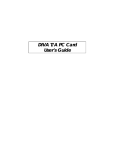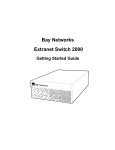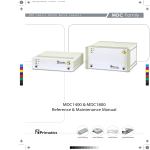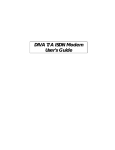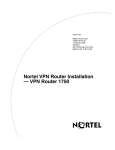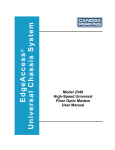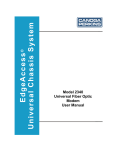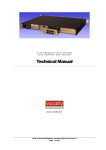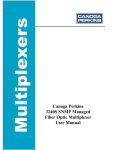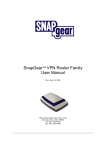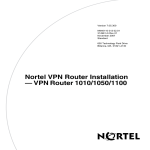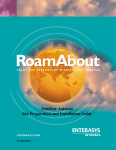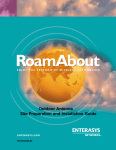Download Nortel Networks 1500 Switch User Manual
Transcript
Getting Started with the Contivity Extranet Switch 1500 Series Part No. 306009-B Rev 00 February 2000 Accuracy Notice The products and specifications, configurations, and other technical information regarding the products contained in this document are subject to change without notice. All statements, technical information, and recommendations contained in this document are believed to be accurate and reliable but are presented without warranty of any kind, expressed or implied, and users take full responsibility for their application of any products specified in this document. Copyright © 2000 Nortel Networks, Inc. All rights reserved. Printed in the USA. February 2000. The information in this document is subject to change without notice. The statements, configurations, technical data, and recommendations in this document are believed to be accurate and reliable, but are presented without express or implied warranty. Users must take full responsibility for their applications of any products specified in this document. The information in this document is proprietary to Nortel Networks, Inc. The software described in this document is furnished under a license agreement and may only be used in accordance with the terms of that license. A summary of the Software License is in Appendix B. Trademarks Nortel Networks, Nortel Networks Extranet Switch 1500, Contivity, Extranet Ready, the Extranet Ready logo, Personal Extranets, Infrastructure for Extranets, and the Nortel Networks logo are trademarks of Nortel Networks, Inc., Microsoft, Windows 95, Windows 98, and Windows NT are registered trademarks of Microsoft Corporation. The Microsoft Internet Explorer logo is a trademark or registered trademark of Microsoft Corporation in the United States and/or other countries. : This product contains RSA Software. TM R This product incorporates MPPC compression from Hi/fn . All other trademarks and registered trademarks are the property of their respective owners. Restricted Rights Legend Use, duplication, or disclosure by the United States Government is subject to restrictions as set forth in subparagraph (c)(1)(ii) of the Rights in Technical Data and Computer Software clause at DFARS 252.227-7013. Notwithstanding any other license agreement that may pertain to, or accompany the delivery of, this computer software, the rights of the United States Government regarding its use, reproduction, and disclosure are as set forth in the Commercial Computer Software-Restricted Rights clause at FAR 52.227-19. 306009-A Rev 00 ii Contents Preface Conventions .....................................................................................................................viii Documentation ..........................................................................................................viii Text ............................................................................................................................. ix User Interface ............................................................................................................. ix Related Publications .......................................................................................................... x Nortel Networks Technical Publications ............................................................................ xi Nortel Networks Customer Service ..................................................................................xii Chapter 1 Introducing the Contivity Extranet Switch The Switch ......................................................................................................................1-1 Components List ......................................................................................................1-4 Chapter 2 Preparing Your Site Selecting a Site ...............................................................................................................2-1 Safety Guidelines .....................................................................................................2-2 Switch Power ON/OFF .............................................................................................2-2 Check the Voltage Switch .........................................................................................2-2 External Vent Cooling and Airflow ............................................................................2-3 Chapter 3 Cabling the Switch Connecting the Cables ...................................................................................................3-2 Power Cord Requirements .......................................................................................3-3 Current Rating ..........................................................................................................3-3 Wall Outlet Connector ..............................................................................................3-3 Power Supply Connector ..........................................................................................3-3 Cord Length and Flexibility .......................................................................................3-3 iii LAN Interface Connections .............................................................................................3-4 LAN Speed Selection ...............................................................................................3-4 Connector Pinouts ....................................................................................................3-4 Single V.35 WAN Interface (Optional) .............................................................................3-5 T1 CSU/DSU WAN Interface (Optional) .........................................................................3-7 Serial Interface Cable (Optional) ....................................................................................3-8 Understanding the LEDs ................................................................................................3-9 Chapter 4 Assigning a System Identity Startup Configuration Requirements ..............................................................................4-2 Management IP Address ..........................................................................................4-2 Subnet Mask ............................................................................................................4-2 Default Gateway (Optional) ......................................................................................4-2 IP Address Configuration Utility ......................................................................................4-3 Requirements ...........................................................................................................4-3 Running the IP Configuration Utility .........................................................................4-3 Serial Interface Configuration .........................................................................................4-6 Prerequisites ............................................................................................................4-6 Procedure .................................................................................................................4-7 Chapter 5 Managing the Switch Recommended Web Browsers .......................................................................................5-1 Platforms Supported ................................................................................................5-1 Browser Versions .....................................................................................................5-1 Display Setting .........................................................................................................5-1 Preparing for Configuration .............................................................................................5-2 Extranet Switch Welcome Display ..................................................................................5-3 Quick Start ...............................................................................................................5-5 Guided Configuration ...............................................................................................5-5 Manage Extranet Switch ..........................................................................................5-5 Registration ..............................................................................................................5-5 Notebook ..................................................................................................................5-5 Logging in and Supplying a Password ............................................................................5-6 iv Quick Start Configuration Prerequisites .........................................................................5-7 Required Environment .............................................................................................5-8 Prerequisites ............................................................................................................5-9 Post Configuration Testing .......................................................................................5-9 Configuration ................................................................................................................5-10 LAN/WAN Interfaces ..............................................................................................5-11 PPTP Users ...........................................................................................................5-12 Administrator ..........................................................................................................5-13 Date and Time ........................................................................................................5-14 Automatic Backup .........................................................................................................5-14 Chapter 6 Extranet Access Client Installation Windows 95 ....................................................................................................................6-1 Windows 98 and Windows NT 4.0 ..................................................................................6-3 Appendix A Specifications and Compliance Physical ......................................................................................................................... A-1 Operating Environment .................................................................................................. A-1 Declaration of the Manufacturer or Importer .................................................................. A-1 Safety Compliance .................................................................................................. A-2 Electromagnetic Compatibility (EMC) ..................................................................... A-2 Harmonics ............................................................................................................... A-2 Appendix B Special Notices v Preface This guide takes you through the necessary tasks to get your Nortel NetworksTM Contivity Extranet Switch 1500TM Series up and running. Topics include: • Introducing the Contivity Extranet Switch • Preparing Your Site • Assigning a System Identity • Managing the Switch • Installing the Extranet Access Client • Rack Mounting • Changing Hardware Configurations Complete details for configuring and monitoring the Switch are in Managing the Contivity Extranet Switch. vii Getting Started with the Contivity Extranet Switch 1500 Series Conventions This guide refers to the Contivity Extranet Switch as the CES or the Switch. It assumes that you are familiar with Web browsers and their general operation. Documentation This document uses the following conventions to distinguish among notes of varying importance: Note: Take notice. Notes contain helpful suggestions or references to materials contained in this document. TIP: Good idea. A Tip is something that might be considered a good idea, whether for security reasons or because it will save you time or effort. IMPORTANT: Take particular notice. Important references contain concepts or information that has bearing on other fields or situations (i.e., what you do here affects other fields or options elsewhere). CAUTION: Be careful. In this situation, you might do something that could result in damage to the equipment or loss of data. WARNING: Danger. You are in a situation that could cause bodily injury. Before working on equipment, beware of the hazards involved with electrical circuitry and standard practices for preventing accidents, such as disconnecting equipment from its power source. viii Preface Text This guide uses the following text conventions: italic text Indicates new terms and book titles. screen text Indicates system output, for example, prompts and system messages. Example: Set Nortel Networks Trap Monitor Filters arrow ( → ) Shows menu paths. Example: Services → Available identifies the Switch services that are available. User Interface Help Button Click the Help button that is located in the upper right of displays to learn about fields on a given page. Where appropriate, the information provides cause and effect of an action; otherwise, it might offer troubleshooting steps. ix Getting Started with the Contivity Extranet Switch 1500 Series Related Publications The following table lists the associated documentation that you will need to configure and manage your Switch and describes the document’s objectives. Related Publications x Document Objective Contivity Extranet Switch Release Notes Provides the latest information, including known problems, workarounds, and special considerations. Managing the Contivity Extranet Switch (included on the CD) Provides complete details to configure, monitor, and troubleshoot your Switch. Preface Nortel Networks Technical Publications You can print Nortel Networks technical manuals and release notes free, directly from the Internet. Go to support.baynetworks.com/library/tpubs/. Find the Nortel Networks product for which you need documentation. Then locate the specific category and model or version for your hardware or software product. Using Adobe Acrobat Reader, you can open the manuals and release notes, search for the sections you need, and print them on most standard printers. You can download Acrobat Reader free from the Adobe Systems Web site, www.adobe.com. You can purchase Nortel Networks documentation sets, CDs, and selected technical publications through the Nortel Networks Collateral Catalog. The catalog is located at support.baynetworks.com/catalog.html: • The “CD ROMs” section lists available CDs. • The “Guides/Books” section lists books on technical topics. • The “Technical Manuals” section lists available printed documentation sets. Make a note of the part numbers and prices of the items that you want to order. Use the “Marketing Collateral Catalog description” link to place an order and to print the order form. xi Getting Started with the Contivity Extranet Switch 1500 Series Nortel Networks Customer Service If you purchased a service contract for your Nortel Networks product from a distributor or authorized reseller, contact the technical support staff for that distributor or reseller for assistance. If you purchased a Nortel Networks service program, contact one of the following Nortel Networks Technical Solutions Centers: xii Technical Solutions Center Telephone Number United States and Canada 800-2LANWAN (800-252-6926); enter Express Routing Code (ERC): 176# Valbonne, France 33-4-92-96-69-68 Sydney, Australia 61-2-9927-8800 Tokyo, Japan 81-3-5402-7041 Chapter 1 Introducing the Contivity Extranet Switch The Switch The Nortel Networks Contivity Extranet Switch 1500 Series provides scalable, secure, manageable extranet access for up to 100 simultaneous users across the Public Data Network (PDN). The Contivity Extranet Switch 1500 Series consists of the 1500, 1510, 1520, and 1530 models. The Switch includes the most popular tunneling protocols, IP Security (IPsec), Point-to-Point Tunneling Protocol (PPTP), Layer 2 Forwarding Tunneling Protocol (L2TP), and Layer 2 Forwarding (L2F). IPsec uses digital certificates, password-based keys, and tokens for authentication; PPTP, L2TP, and L2F use Challenge Handshake Authentication Protocol (CHAP) or Password Authentication Protocol (PAP) for authentication. The PPTP implementation for the Switch supports MS-CHAP authentication with 56- to 128-bit key encryption. Figure 1-1 shows an intranet and an extranet. 1-1 Getting Started with the Contivity Extranet Switch 1500 Series LAN Cable or DSL E -M ail Server ISP PO P Contivity Extranet Switch NT Server Rem ote Em ployee Firewall ISP POP P artner ISP P OP 56K M odem ISP POP Router Authentication Server ISDN Reseller Internet Intranet Extranet Figure 1-1. An Intranet and the Internet Make Up an Extranet The Switch provides more security than traditional remote access schemes due to the combination of authorization, authentication, privacy, and access control on a per user basis. Additionally, the IPsec protocol and related Internet Security Association & Key Management Protocol (ISAKMP) and the Oakley key establishment protocol support further enhance the security offering. For authentication and access control, the Switch supports an internal or external Lightweight Directory Access Protocol (LDAP) server and external Remote Authentication Dial-In User Service (RADIUS) servers. 1-2 Introducing the Contivity Extranet Switch To restrict access, the Switch uses packet filtering based on Protocol ID, Direction, Source and Destination IP addresses, Source and Destination Ports, and TCP connection establishment. Additionally, Nortel Networks provides you with a set of predefined filters that you can use either directly or tailor to your network needs. The unique quality of service (QoS) mechanisms include call admission and packet forwarding priorities, and support for Resource ReSerVation Protocol (RSVP). The HTML and Java Web management interface allows different Switch administrators to have different access rights, including configuration, status, and monitoring. The Switch offers RADIUS accounting support and extensive logging, including events, system, configuration, and security logs. Figure 1-2 shows a front view of the Switch. Figure 1-2. The Switch, Front View The Extranet Switch 1500 Series must be placed only in a horizontal position. 1-3 Getting Started with the Contivity Extranet Switch 1500 Series Components List The following table lists all of the components and accessories of the Switch. Examine the product packaging to be sure that you have all the necessary components. Note that the Extranet Switch 1500 Series has no user-serviceable components. Description Quantity Extranet Switch 1500 Series 1 Power Cord (ordered separately) 0 Molded Serial Cable DB9/DB25-to-DB9/DB25 1 WAN V.35 Cable (only with 1520) 1 Contivity Extranet Switch CD-ROM 1 Recovery Diskette 1 IP Address Configuration Utility Diskette 1 Getting Started Guide (this book) 1 Release Notes 1 If for any reason you have not received all of the materials listed above, contact Nortel Networks Customer Service. 1-4 Chapter 2 Preparing Your Site This chapter provides information that you should read before you begin cabling and configuring the Contivity Extranet Switch 1500 Series. This information includes selecting an appropriate site, safety guidelines, information on the power cord, voltage settings, and external vent cooling and airflow recommendations. Selecting a Site This Switch is designed to operate reliably in a typical office environment. You should select a site that meets the following criteria: • • Has a desktop or surface that is off the floor. Has access to a grounded, three-pronged power outlet. - Uses a NEMA 5-15R outlet for 100-120 VAC or a NEMA 6-15R outlet for 200-240 VAC (US and Canada). - Uses a three-pronged power outlet that is applicable for the region’s electrical code (elsewhere). • • Remains dust free and clean. Is away from heat sources and is well ventilated. • Allows adequate clearance for cooling and airflow -- about 10 centimeters (3.93 inches) in back, 5 centimeters (1.96 inches) on each side, and 10 centimeters (3.93 inches) in front. 2-1 Getting Started with the Contivity Extranet Switch 1500 Series Safety Guidelines Hazardous Conditions Inside the Switch Hazardous voltage, current, and energy levels are present inside the Switch. Do not open the Switch; there are no user-serviceable parts inside. Contact Nortel Networks Customer Support for service. Switch Power ON/OFF The On/Off power button on the front panel of the Switch does not completely eliminate (turn off) the AC power from the Switch. To eliminate AC power from the Switch completely, unplug the AC power cord from the power supply or wall outlet. Check the Voltage Switch WARNING: Incorrectly setting the voltage will damage the power supply. See Figure 3-1 on page 3-2. CAUTION: Make sure that the power service connection is through an outlet that is properly grounded. Before you connect the power cord to the back panel of the Switch, ensure that the voltage selector switch is correctly set to the appropriate AC line source voltage. For line voltages between: • 100 and 127 VAC, set the power supply line voltage selector to 115V (115 VAC). • 200 and 240 VAC, set the power supply line voltage selector to 230V (230 VAC). Verify that the correct voltage (115V or 230V) is visible on the switch. See Figure 3-1 on page 3-2. 2-2 Preparing Your Site External Vent Cooling and Airflow The Switch has external vents for cooling and air flow on: • The chassis bezel • The back panel • On each of the side panels Keep the side vents clear of obstruction to ensure proper cooling of the Switch. 2-3 Chapter 3 Cabling the Switch This chapter provides information on the following: • Cabling • Local area network (LAN) connections • Wide area network (WAN) connections • Serial interface • LEDs For the Contivity Extranet Switch 1500 Series: • The 1500 and 1510 support connections to LAN interfaces • The 1520 supports connections to Single V.35 interfaces • The 1530 supports connections to T1 CSU/DSU interfaces Additionally, this chapter cites the LAN/WAN pinouts and the Switch’s LED descriptions. Figure 3-1 shows a back view of the Contivity Extranet Switch that shows various connector locations. 3-1 Getting Started with the Contivity Extranet Switch 1500 Series 115/230V Selector Switch Power Connector LNK ACT 100TX DATA 10/100 BaseT LAN Card Connector Figure 3-1. Serial Connector Extranet Switch Back View Connecting the Cables You must connect your cables as follows: • Connect the power cord to the back of the Switch and to the electrical outlet. WARNING: Connect the LAN and serial port cables before you plug the Switch’s power cord into the outlet. • 3-2 Connect the LAN/WAN card cables as necessary. Cabling the Switch Power Cord Requirements WARNING: 1. Do not modify the AC power cord if it is not the exact type that is required for your power outlet. 2. Before you connect the power cord to the back panel of the Switch, ensure that the voltage selector switch is correctly set to the appropriate AC line source voltage. See page 2-2. Current Rating CAUTION: You should protect your Switch by plugging it into a surge suppressor. The power cord must be rated for the available AC voltage, and it must have a current rating which is at least 125 percent of the Switch's current rating. See the “Physical, Electrical” specifications on page A-1. Wall Outlet Connector The power cord must be terminated in a male plug with appropriate grounding. The power cord must have certification marks from an acceptable regional agency. Power Supply Connector The connector that you plug into the Switch power supply AC receptacle must be an IEC 320, Sheet C13, female. Cord Length and Flexibility The power cord must be less than 4.5 meters (14.7 feet) long, and it must be a flexible HAR (harmonized) cord or VDE-certified cordage to comply with the Switch's safety certifications. 3-3 Getting Started with the Contivity Extranet Switch 1500 Series LAN Interface Connections The LAN interface is available for the Contivity Extranet Switch 1500 and 1510. There is at least one LAN interface connection, which provides a connection to the Web for management. 100BASE-TX connections require Category 5, twisted-pair wire. The 100BASE-TX specification supports 100 Mb/s transmission over two pairs of Category 5 twisted-pair Ethernet wiring; one pair each for transmit and receive operations. 100 meters is the maximum recommended cable segment length between a 100BASE-TX repeater and a workstation (due to signal timing requirements). This wiring scheme complies with the EIA 568 wiring standard. 10BASE-T connections can use Category 3, 4, or 5 twisted-pair wiring. LAN Speed Selection The Switch automatically determines the speed of the LAN connection during power-up. To change the speed, simply power down the unit, connect to the desired LAN, and power the unit back up. Connector Pinouts The LAN connectors on the Switch are RJ-45 straight-through. The following illustration shows the Switch connector's 10/100BASE-TX pinouts. RD+ RD- TD+ RD- 12 3 4 5 6 7 8 Figure 3-2. 3-4 10/100BASE-TX Pinouts Cabling the Switch Single V.35 WAN Interface (Optional) The Single V.35 WAN connector is located on a PCI card that offers a separate DB26S connector that provides the signals needed to interface to V.35 equipment. Included in the accessory box is a cable that maps the DB26S signals to a standard V.35 connector. Table 3-1 shows the cable pinouts. Table 3-1. DB26S-to-V.35 Cable Pinouts DB26 Signal V.35 1 Shield A 2 TXDA P 3 RXDA R 4 RTSA C 5 CTSA D 6 DSRA E 7 GND B 8 DCDA F 9 RXCB X 10 DCDB no conn 11 SCTEB W 12 TXCB AA 14 TXDB S 15 TXCA Y 16 RXDB T 17 RXCA V 18 LL L 19 RTSB no conn 20 DTRA H 21 RL N 22 DSRB j 23 DTRB no conn 24 SCTEA U 25 TM NN 3-5 Getting Started with the Contivity Extranet Switch 1500 Series 26 M0<-SIGNAL GROUND B 27 M1<-SIGNAL GROUND B 28 M2 no conn The following notes apply to the Single V.35 WAN Interface: 3-6 • You will need a DSU/CSU (digital service unit/channel service unit) between the WAN connection and the Switch. • At each end, Cable shield and connector shell must connect respectively to pin A of 34-pin connector and pin 1 of the standard 28-pin connector. • The term “no conn” means the wire is not connected to a pin in the 34-pin connector. • Wires 12B, 13A, and 14B connect to pin B in the 34-pin connector. • Unused pins in the 34-pin connector need not be present. • Do not connect Shield to Signal Ground as these are separate signals. • The pair suffix A or B refers to an individual wire within a twisted pair. Cabling the Switch T1 CSU/DSU WAN Interface (Optional) The T1 CSU/DSU WAN interface is available for the Contivity Extranet Switch 1530. The T1 CSU/DSU WAN crossover cable crosses the blue pair with the orange pair. This is different from the commonly available crossover cable, which crosses the green pair with the orange pair. No cables are supplied with the T1 CSU/DSU. Table 3-2 shows the cable pinouts. Table 3-2. T1 CSU/DSU Cable Pinouts DB26S Signal T1 CSU/DSU 1 RXDA->TXDA 5 2 RXDB->TXDB 4 3 not used 3 4 TXDB<-RXDB 2 5 TXDA<-RXDA 1 6 not used 6 7 not used 7 8 not used 8 The cable will operate properly if pins 3, 6, 7, and 8 are not connected. 3-7 Getting Started with the Contivity Extranet Switch 1500 Series Serial Interface Cable (Optional) Nortel Networks recommends that you use the IP Address Configuration Utility diskette for easy initial IP address configuration (refer to page 4-3 for details). However, Nortel Networks ships a serial cable with the Switch. Optionally, you can use the Serial Interface to provide the Switch with a Management IP Address, subnet mask, and default gateway address (refer to page 4-2 for details). Later, you can use the serial interface configuration menu to perform management functions that you might need if problems were to arise. The serial cable provided with the Switch is a DB9/DB25-to-DB9/DB25. This provides a crossover (transmit-to-receive and receive-to-transmit). The DB9 connector goes into the Switch and the other DB9 or DB25 connector goes into your workstation. You should ignore the extra DB25 connection that is attached to the Switch. Table 3-3 shows the multiple cable DB-9/DB25 serial interface cable pinouts. Table 3-3. Multi-DB-9 and DB-25 Connector Pinouts Serial Port DB-9 Connector Serial Port DB-25 Connector Serial Port DB-25 Connector Serial Port DB-9 Connector Pinout Signal Pinout Signal Pinout Signal Pinout Signal 2 RXD 3 TXD > 2 RXD 3 TXD 3 TXD 2 RXD > 3 TXD 2 RXD 4 DTR 20 DSR > 6 DTR 6 DSR 5 Ground 7 Ground > 7 Ground 5 Ground 6 DSR 6 DTR > 20 DSR 4 DTR 7 RTS 4 RTS > 5 CTS 8 CTS 8 CTS 5 CTS > 4 RTS 7 RTS 3-8 Cabling the Switch Understanding the LEDs The Power LED is green when the power is on; if it is flashing, there is a hardware failure and you should contact Nortel Networks. The Hard Disk LED is green, and when it flashes the Switch is either reading or writing to the disk. The LAN Port LED is green, and when it flashes the Switch is either transmitting or receiving data. Start the Switch and confirm that the interfaces are cabled properly by examining the two LEDs located adjacent to the RJ-45 connector of the LAN port, or the LEDs located on the card panel. Figure 3-3 shows the LAN Port LEDs. Look at the condition of the LEDs, then examine the corresponding LED tables to better understand the indications. Orange Green Figure 3-3. LAN Port LEDs Table 3-4. LAN Port LED Indicators LED Indicator Description Orange On The cable connections between the LAN port and the hub are good. Off The cable connections between the LAN port and the hub are faulty. On or Flashing The LAN port is sending or receiving network data. The frequency of the flashes increases with increased traffic. On The LAN port is operating at 100 Mb/s. Off The LAN port is operating at 10 Mb/s. Green (100) 3-9 Getting Started with the Contivity Extranet Switch 1500 Series Figure 3-4 shows the Single V.35 LEDs. Look at the condition of the LEDs, then examine the corresponding LED tables to better understand the indications. LE D 4, R ed LED 3, G reen 3-10 LED 2, Blue LED 1, Yellow Figure 3-4. Single V.35 LEDs Table 3-5. Single V.35 LED Indicators LED Description LED1 Power is on to the adapter and the onboard microcode is loaded. LED2 The signals CDC and DSR are on between the DSU and the adapter. LED2 detects receive link status. LED3 Cable is detected. LED4 No external transmit clock source is available. Cabling the Switch Figure 3-5 shows the T1 CSU/DSU LEDs. Look at the condition of the LEDs, then examine the corresponding LED tables to better understand the indications. LE D 4, R ed LED 3, G reen LED 2, Blue LED 1, Yellow Figure 3-5. T1 CSU/DSU LEDs Table 3-6. T1 CSU/DSU LED Indicator LED Description LED1, Yellow Yellow alarm LED is lit when the far-end equipment is in the red alarm condition. LED2, Blue Blue alarm LED is lit when receiving an upstream failure denoted by an alarm indication signal (AIS). LED3, Green Normal operation. LED4, Red Red alarm is lit when a loss of signal (LOS) or out of frame (OOF) condition is detected on the receive signal. All LEDs off Port disabled. 3-11 Getting Started with the Contivity Extranet Switch 1500 Series Figure 3-6 shows the PCI card 10/100BASE-TX LAN LEDs for the Contivity Extranet Switch 1510. This does not apply to the 1520 or 1530. Look at the condition of the LEDs, then examine the corresponding LED table to better understand the indications. Link LED LNK ACT Activity LED 100 TX 100Mb/s LED DATA Figure 3-6. 10/100BASE-TX LAN LEDs Table 3-7. 10/100BASE-TX LAN LED Card Indicators LED Indicator Description LNK On The cable connections between the card and the device to which this interface is attached are good. Off The cable connections between the card and the device to which this interface is attached are faulty. On or Flashing The card is sending or receiving network data. The frequency of the flashes increases with increased traffic. Off The card is not sending or receiving data. On Operating at 100 Mb/s. Off Operating at 10 Mb/s. ACT 100 TX 3-12 Chapter 4 Assigning a System Identity This chapter describes how to assign a Management IP address, subnet mask, and optional default gateway address to your Switch. The Management IP address is used for all system services, such as HTTP, FTP, and SNMP. The Management IP address enables you to manage the Switch from a Web browser. Initial Configuration OptionsTable 4-1 describes the choices you have when first configuring the Switch’s required parameters. The IP Address Configuration Utility diskette, which comes with your Switch, searches for the serial numbers of unconfigured Switches. It then displays a table for you to enter the Management IP address, subnet mask, and default gateway (optional). To configure the Switch from the serial interface configuration menu, you must first connect the serial interface cable to the Switch. Then you can use a terminal emulation application to enter the Management IP address, subnet mask, and default gateway (optional). Table 4-1. Initial Configuration Options Initial Configuration Method Result IP Address Configuration Utility (Recommended) Sets Management IP Address, Subnet Mask, Serial Interface and Default Gateway Configuration Menu (optional) (Optional) Advantages/ Disadvantages Utility diskette makes initial configuration easy Must connect the serial interface cable 4-1 Getting Started with the Contivity Extranet Switch 1500 Series Startup Configuration Requirements This section describes the fields that you must complete with either the IP Address Configuration Utility or the serial interface configuration menu procedure. Management IP Address Enter a Management IP address for the system. You need this address to manage all system services, such as HTTP, FTP, and SNMP. This address must be accessible from one of the Switch's private physical interfaces. Therefore, the Management IP address must map to the same network as one of the private interfaces. For example, if you plan to assign IP address 10.2.3.3 with Subnet Mask 255.255.0.0 to the private physical interface, then the Management IP address must reside in the 10.2 network. Carefully record the Management IP address. Later, during the Quick Start or the Guided Configuration, you need to supply IP addresses for the physical interfaces. Subnet Mask The Subnet Mask defines how many bits of the IP Address represent the network the device is on and how many bits represent the host’s ID on the network. The device uses the Subnet Mask to determine which IP Addresses are directly reachable on the network and which must be routed through a gateway. A sample IP Address is 10.2.3.3 with a Subnet Mask of 255.255.0.0. This indicates that all hosts with addresses 10.2.n.n are directly reachable. Default Gateway (Optional) The Default Gateway is where packets are routed onto the private network if there is not a specific route in the routing table to the desired location. 4-2 Assigning a System Identity IP Address Configuration Utility Use this utility for the initial configuration of a Switch. Requirements To assign the Switch a Management IP address, you need: • A PC running Windows 95® or Windows NT® with a functioning TCP/ IP stack • The PC running on the same subnet as the Switch you are configuring • The PC connected to an operational network connection If your environment does not match these requirements, then you must use the serial interface configuration. To test the function of your TCP/IP stack, send a PING command to any host. Running the IP Configuration Utility The program ExtNetIP.exe is on a diskette labeled IP Address Configuration Utility that accompanies the Switch. You can copy the utility to your hard disk and execute it from there, or you can load it from the diskette drive. The ExtNetIP.exe program launches the IP Address Configuration Utility, which allows you to assign a Management IP address and subnet mask to the Switch. To run the configuration utility: 1. Insert the diskette into the A: drive and select Start→Run: a:\ExtNetIP.exe or, open the “My Computer” icon on the desktop and open the “3½ Floppy (A:)” drive, then double-click on the icon: 4-3 Getting Started with the Contivity Extranet Switch 1500 Series The following display appears while the program searches for an unconfigured Switch. Figure 4-1. Serial Number Search Display The program automatically enters the Serial Number for the first available Switch into the table of Contivity Switches. Figure 4-2. 4-4 IP Address Configuration Utility Display Assigning a System Identity 2. Assign a Management IP Address and Subnet Mask to the Switch; the Default Gateway address is optional and you can add it later (see Startup Configuration Requirements on page 4-2 for descriptions of the required fields). If you have more than one Switch, click Search to automatically add the additional Switch serial numbers. To verify the switches that have been discovered, you can refer to the serial number on the bar code on the bottom of the Switch. The serial number on the back of the Switch is that of the motherboard manufacturer. 3. Click Apply to configure the Management IP Address, Subnet Mask, and Default Gateway on the Switch. The IP Address Configuration Utility screen disappears. When the Switch updates its configuration with the Management IP Address, Subnet Mask, and optional Default Gateway, your default Web browser automatically opens to the Contivity Extranet Switch Welcome screen. 4. Click Close to shut down the IP Address Configuration Utility. Note: Before moving the Switch from one network to another, change the Management IP address, Subnet Mask, and Default Gateway. Otherwise, you need to follow the Serial Interface Configuration procedure to access your Switch because it will not be accessible from a Web browser with an invalid address. 4-5 Getting Started with the Contivity Extranet Switch 1500 Series Serial Interface Configuration Use the IP Address Configuration Utility (see to page 4-3) to configure the Switch with its initial IP address configuration. Alternatively, you can use the serial interface configuration menu to access the Switch from the serial interface of your PC. Typically the serial interface configuration procedure is only necessary in a system recovery situation. The serial interface configuration menu allows you to give the Switch a Management IP address, Subnet Mask, and Gateway IP Address so that you can use a Web browser for management. Prerequisites The terminal emulator on your PC must use the following communications parameters: 4-6 • 9600 Baud • 8 Data bits • 1 Stop bit • No Parity • No Flow Control Assigning a System Identity Procedure 1. Connect the serial cable from the Switch’s serial cable port to a terminal or a PC communications port. It can take the system approximately 3 minutes to start up. 2. Using a terminal emulation program, such as Hyper Terminal, press Enter and supply a user name and password when prompted. The factory default user name and password are: User name: admin Password: setup A menu appears that allows you to enter the following: 3. • Management IP Address • IP Subnet Mask • Gateway IP Address (optional) • Allow HTTP Management (default) • Interface IP Address • Controlled Crash • Reset to Factory Defaults Follow the screen prompts. Some of the descriptions of the fields required to complete this procedure are in the section, “Startup Configuration Requirements,” on page 4-4-2. Other descriptions follow: Allow HTTP Management enables you to manage the Switch using a Web browser. A Controlled Crash forces the Switch into a hard crash state, which creates a core dump file that Nortel Networks Customer Support can analyze to help diagnose problems, such as the Switch is hung or it does not respond to PINGs. Do not select “C) Controlled Crash” unless instructed to do so by Nortel Networks. Reset to Factory Defaults returns the Switch to its factory default configuration. A sample display follows: 4-7 Getting Started with the Contivity Extranet Switch 1500 Series Welcome to the Nortel Networks Extranet Switch Copyright 1998 and 1999, Nortel Networks Date: 1/29/99 Unit Serial Number: 01001 Please enter the administrator's username: admin Please enter the administrator's password: setup 1) Management IP Address* 2) IP Subnet Mask 3) Gateway IP Address* 4) Allow HTTP Management 5) Interface IP Address* C) Controlled Crash R) Reset to Factory Defaults E) Exit *0.0.0.0 resets to factory default value of NULL Please select a menu choice (1 - 5, C, R, E): Figure 4-3. 4. Sample Serial Interface Display After you complete the configuration, type E to Exit. You can then manage the Switch from a Web browser. Important: This Administrator's Password is also the Primary Administrator's Password. This password guarantees access to the Switch from the serial port or a Web browser. 4-8 Chapter 5 Managing the Switch This chapter describes the recommended Web browsers, the default login, and passwords that you need to access the Nortel Networks Extranet Switch, and the Quick Start Configuration. Recommended Web Browsers Nortel Networks Extranet Manager uses Java, JavaScript, and HTML features. For the management interface to function properly, verify that your Web browser meets the following minimum requirements. Platforms Supported The Switch supports Windows 95, Windows 98, Windows NT, and Macintosh® operating systems. Browser Versions The Switch supports the following Web browsers: • Microsoft Internet Explorer--Version 4.0 or later is required. • Netscape Communicator--Version 4.0 or later is required. Display Setting Verify that the system display color setting is 256 colors or greater. 5-1 Getting Started with the Contivity Extranet Switch 1500 Series Preparing for Configuration To properly prepare for Installation and Configuration of the Contivity Extranet Switch, you should have the following: 5-2 • A Management IP Address for the system. You need this address to manage all system services, such as HTTP, FTP, and SNMP. • An IP Address for the LAN port that is available on the system board. • Any number of Public IP Addresses; for example, one IP address for each Public LAN/WAN Interface. • A plan to distribute IP addresses to clients when connections are requested; for example, using a DHCP server or an internal client address pool (with an address pool you need a range of IP addresses). • An Authentication database. If you are not using internal authentication with the LDAP database, be sure you have either the external LDAP or the RADIUS server IP Address and password or Shared Secret (password). • An external accounting server, such as RADIUS, with its IP Address and Shared Secret (password). • Client dial-in. Prepare the clients for the type of tunneling protocol they plan to use. The PPTP client application is available for Windows 95 on the Nortel Networks CD, and it comes with the Windows 98 and Windows NT operating systems. Nortel Networks also provides the IPsec client on the Nortel Networks CD. • A complete network topology of the environment in which you are testing the Switch, including the Switch, the default router address, and any other IP addresses that might be required. Managing the Switch Extranet Switch Welcome Display The Welcome screen allows you to enter any of the configuration areas for the Extranet Switch, including: • Quick Start Configuration • Guided Configuration • Manage Extranet Switch • Registration • Notebook Before entering the configuration options, you should first register to activate licenses, warranties, and services. The alternatives you have when first configuring your Switch are shown in Table 5-1. Nortel Networks recommends that you begin with the Quick Start or the Guided Configuration. Once you are familiar with the Switch’s navigation menu and capabilities, then you can select Manage Extranet Switch. Table 5-1. Configuration Alternatives Configuration Type Results Quick Start Configure and Test a basic PPTP configuration Guided Structured Switch configuration and management Manage Comprehensive Switch configuration and management Following is a sample Extranet Switch Welcome display, followed by descriptions of each configuration option. A detailed checklist describes what you need to properly configure your Switch, followed by full details of the different procedures. Complete details for configuring and monitoring the Switch are in the Nortel Networks Contivity Extranet Switch Administrator's Guide. 5-3 Getting Started with the Contivity Extranet Switch 1500 Series Figure 5-1. 5-4 Switch Welcome Display Managing the Switch Quick Start Click to begin the Quick Start Configuration. This option allows you to configure interfaces, set up PPTP tunnels for up to three users, and establish a connection to the Switch. Provided you have the information required to set up the Switch, the Quick Start can take as little as 15 minutes to complete. Guided Configuration Click to begin the Guided Configuration. This option allows access to all Configuration Management facilities. However, the design and structure of the Guided Configuration is best followed using the top-to-bottom layout provided. This approach walks you through the entire Navigational Menu from the Profiles to the Status selections. Each functional area begins with a summary of the objectives and then steps you through the area (such as, Profiles), one subsection at a time. Online context-sensitive Help is available for each subsection. Provided you have the information required to set up the Switch, the Guided Configuration can to take two to three hours to complete, depending on whether your configuration is simple or more complicated. Manage Extranet Switch Click to begin a standard configuration and management session. This option allows access to all configuration management facilities. You should follow the Quick Start or Guided Configuration for your first configuration. Registration Click to register the Switch with Nortel Networks. This only take a few minutes and gives you access to the latest software and technical tips. Your Switch requires Internet access in order to register. Notebook Click to activate the notebook display mode. The Contivity Extranet Switch Manager then runs in notebook display mode, which better fits notebook displays. 5-5 Getting Started with the Contivity Extranet Switch 1500 Series Logging in and Supplying a Password Start up a Web browser and enter your Switch's Management IP Address. Select an option in the navigational menu and submenu. When you are prompted for the Login and Password, enter the system default Login and Password in lowercase letters, as follows: Login: admin Password: setup IMPORTANT: If you change your password and later need to access the Serial Interface Configuration, you must enter the modified password. The factory default password is no longer valid in this case. Also, make sure you change the default Administrator's Login and Password as soon as possible (refer to the Admin→Administrator display). You should then guard the Login and Password carefully. The password is case sensitive. 5-6 Managing the Switch Quick Start Configuration Prerequisites This screen acts as a checklist for you to prepare for the Quick Start configuration. Assembling the information beforehand, and verifying that you can establish a PPTP Client session, makes Quick Start easy. Figure 5-2. Quick Start Prerequisites Display 5-7 Getting Started with the Contivity Extranet Switch 1500 Series Required Environment This section describes the environment that you need for the Quick Start Configuration. If this does not describe your environment, use the Guided Configuration. Point-to-Point Tunnel Protocol (PPTP) tunnel access method PPTP is a tunneling protocol supported by Nortel Networks, Microsoft, and other vendors. The PPTP client is available for Windows 95 on the Nortel Networks CD and comes with Windows 98 and Windows NT 4.0 and later operating systems. Static IP addresses, Dynamic Host Configuration Protocol (DHCP) server address allocation, or an Internal Client Address Pool A DHCP Server on the private LAN segment dynamically assigns IP addresses on behalf of remote users. The DHCP server is automatically discovered by broadcasting on the private interface that is associated with the Management IP Address. With an Internal Client Address Pool, you need a range of IP addresses. Local Lightweight Directory Access Protocol (LDAP) database authentication LDAP is a standard protocol for Internet directory services that is based on directory entries. A directory service is a central repository of user information. The local database is internal to the Switch. The Switch for the Quick Start procedure sets up an LDAP server and associated database locally. Later, you can switch to a network-available external LDAP server using the LDAP Intermediate File (LDIF) data format. 5-8 Managing the Switch Prerequisites You must meet the following prerequisites: • • IP configuration information (refer to Startup Configuration Requirements on page 5-7 for additional information): - Management IP Address for the Switch - Subnet Mask for the local subnet User IDs and Passwords: - PPTP Users (up to three) - Administrator Post Configuration Testing To test your configuration, verify that a PPTP remote user can dial in from an external system. Refer to the Contivity Extranet Switch Administrator's Guide, the Switch’s online help, and the Microsoft PPTP documentation for additional information. 5-9 Getting Started with the Contivity Extranet Switch 1500 Series Configuration This screen allows you to add a LAN port IP Address and Subnet Mask, establish the tunnel as Private (your private LAN) or Public (public data networks), and configure up to three PPTP Users and an Administrator with User IDs and Passwords. You can also set the system's date and time. The following figure show partial displays of the Quick Start Configuration screen. Figure 5-3. 5-10 Quick Start Configuration Display Managing the Switch LAN/WAN Interfaces Interfaces Lists the Management IP Address, LAN/WAN port, and LAN card. IP Address Enter an IP address for each interface on the Switch, including the LAN port. The Switch uses these IP addresses for tunnel creation. The IP Address consists of 32 bits, which are written as four octets in dotted-decimal format as follows: 192.168.34.21 You must supply the interface IP Address configuration information, not the Management IP Address that you already configured through the initial IP Address configuration. Subnet Mask The Subnet Mask defines how many bits of the IP Address represent the network the device is on and how many bits represent the host’s ID on the network. The device uses the Subnet Mask to determine which IP Addresses are directly reachable on the network and which are only reachable through a gateway. A sample IP Address is 10.2.3.3 with a Subnet Mask of 255.255.0.0. This indicates that all hosts with addresses 10.2.n.n are directly reachable. Default Gateway If the routing table contains no specific route to the desired location, the Default Gateway packets are routed onto the private network. Type The default configuration assigns the Management LAN interface as Private and the LAN card interface as Public. 5-11 Getting Started with the Contivity Extranet Switch 1500 Series Public Indicates that this interface is attached to a Public data network like the Internet. On a Public interface, the Switch rejects non-tunneled protocols and accepts only tunneled protocols, such as IPsec, PPTP, L2TP, L2F and the diagnostic protocol PING. A host can send only enough packets to a Public interface to establish a tunnel connection. If the tunnel is not established before the preset maximum-number-of packets-allowed counter is reached, then the Switch discards the packets from that host. Private Indicates that this interface is attached to the Private network and that it can accept non-tunneled networking protocols such as TCP/IP, FTP, and HTTP. The Private interface also accepts tunneled protocols (such as IPsec, PPTP, L2TP, and L2F) that can be used for secure management access to the Switch. PPTP Users User ID Enter a User ID. The User ID works along with the password as the authentication mechanism when attempting to access your local LAN through the Switch. Password Enter a user Password. You should use a minimum of eight characters, including upper and lowercase letters and numbers. Avoid using common names and words found in the dictionary. For example, a password constructed as “AxSessPw4U” is much better than “dog” or “Barney.” Note: Do not use a password of 16 pound signs (#). 5-12 Managing the Switch Confirm Password Reenter the assigned password to verify that you have typed the intended password correctly. Remote User Static IP Address Enter an IP Address to be assigned to this user when establishing a PPTP tunnel session. This IP Address is unnecessary if you assign user IP addresses from either a DHCP server or an internal address pool. Administrator The Administrator Settings allow you to change the Primary Administrator User ID (UID) and Password. The Primary Administrator User ID and Password combination always has access to all displays and controls. You can also use this UID to access the serial port. There can be only one Primary Administrator. User ID Enter an appropriate User ID for the Primary Administrator. This UID has the privileges to modify and view all controls in the Switch. Password Enter a user Password for the Primary Administrator. Note: Do not use a password of 16 pound signs (#). Confirm Password Reenter the assigned password for the Primary Administrator to verify that you have typed the intended password correctly. 5-13 Getting Started with the Contivity Extranet Switch 1500 Series Date and Time Date Enter the current month, day, and year (mm/dd/yyyy). Time Enter the current hour, minute, and seconds (hh:mm:ss) as displayed by a 24-hour clock (00:00:00 to 23:59:59). Automatic Backup The Automatic Backup screen under the Manage configuration option allows you to configure regular intervals when your system files are saved to designated host backup file servers. IMPORTANT: You should configure Automatic Backups immediately so that you do not lose system or configuration information in case of problems. You configure the Automatic Backup servers from the Admin→Automatic Backup display. 5-14 Chapter 6 Extranet Access Client Installation Windows 95 To install the Nortel Networks Extranet Access Client onto a Windows 95 PC, you must copy and load the four files that are on the Nortel Networks Extranet CD in the Client folder onto your hard drive. International software users must go to the Microsoft Web site (http://support.microsoft.com/support) to get the MSDUN13 patch. 1. First, install Msdun12.exe (Microsoft Dial-up Networking update) by double-clicking on the file name. The installation is self-explanatory. You might need your Windows 95 CD (in case the CD was not copied onto your drive). During the installation you will be asked to reboot your system twice. 2. Next, install Wsockupd.exe (Winsock update) if you are using the retail version of Windows 95. Reboot your system after installing the update. You now have the Microsoft PPTP tunneling client installed. 3. Complete the IPsec installation by running the Eac_20d.exe, (Nortel Networks Extranet Access Client). The installation is self-explanatory. You might need your Windows 95 CD-ROM (in case the CD was not copied onto your drive). When prompted at the end of the installation, reboot your system. 4. If you do not care about operating within the Network Neighborhood, skip this step. To operate within the Network Neighborhood, enable the following items under the Network Control Panel (click the Start menu button, select Settings→Control Panel, then double-click on the Network icon to open the Network Control Panel). 6-1 Getting Started with the Contivity Extranet Switch 1500 Series 6-2 a. Under the box titled “The following network components are installed,” verify that the Client for Microsoft Networks is listed. If it is not, click on the ADD button, then select CLIENT, then click the ADD button again. Select Microsoft followed by Client for Microsoft Networks and finally the OK button. You will need your Windows 95 CD if it is not already copied onto your system. b. Under the same box titled “The following network components are installed,” make sure that NetBEUI is not installed. To verify this, scroll down through the list box and look for any lines that have NetBEUI in them. If there are any lines that include NetBEUI, click on the line, and then click on the Remove button. This forces the Network Neighborhood to use NetBIOS over TCP/IP, which is compatible with the Extranet Switch. c. Under the Identity tab, configure the Workgroup to be the same as your company’s internal workgroup. For example, “Nortelnetworks.” d. Next under the Identity tab, verify that the Computer Name is different from your PC at work. Otherwise, you would be attempting to log a second unit with the same name onto the network. e. If you have made any changes in the Network Control Panel, click OK and then reboot the system. f. Double-click on the Extranet Connection Manager icon. g. Enter a new Connection Profile Name. h. Create a new Dial-up Connection. i. Click the Tool button (next to the Dial-up Connection list box), select New, and follow the wizard. j. Create a new Extranet Connection. k. Click the Tool button (next to the Extranet Connection list box), select New IPsec Connection, and follow the wizard. l. Click the Connect button. Extranet Access Client Installation Windows 98 and Windows NT 4.0 To install the Nortel Networks Extranet Access Client onto a Windows 98 PC or Windows NT 4.0 workstation, you must copy the Extranet Access Client (Eac_20d.exe) that is on the Contivity Extranet Switch CD in the Client folder onto your hard drive. 1. Install Eac_20d.exe by double-clicking on the program name. The installation is self-explanatory. When prompted at the end of the installation, reboot your system. 2. If using the Extranet Access Client over a dial-up connection: Windows NT: Install the Remote Access Service under the Network Control Panel (from the Start menu, select Settings→Control Panel, then double-click on the Network icon to open the Network Control Panel). Select the Services tab and click on Add. Scroll down to select “Remote Access Service” and click on OK. Windows 98: Under the Network Control Panel (from the Start menu, select Settings→Control Panel), select Add→Adapter→ Microsoft→Dial-up Adapter. 3. Under the Protocols tab for Windows NT or under the Network Control Panel for Windows 98, verify that NetBEUI is not installed. If NetBEUI is listed, click on it, then click on the Remove button. This will force the Network Neighborhood to use NetBIOS over TCP/IP, which is compatible with the Switch. Click on the OK button and reboot your system. 4. Double-click on the Extranet Connection Manager icon. a. Enter a new Connection Profile Name. b. Create a new Dial-up Connection. c. Click on the Tool button (next to the Dial-up Connection list box), select New, and follow the wizard. d. Create a new Extranet Connection. e. Click on the Tool button (next to the Extranet Connection list box), select New IPsec Connection, and follow the wizard. f. Click on the Connect button. 6-3 Appendix A Specifications and Compliance Physical Depth: 13 in. (33.02 cm) Width: 9.5 in. (24.13 cm) Height: 3.5 in. (8.89 cm) Weight: 10.0 lbs (4.539 kg) Electrical: 110-127V, 2.0A; 200-240V, 1.25A 50-60Hz Operating Environment Temperature: 50°F-95°F (10°C-35°C) Relative Humidity: 10%-90% non-condensing Declaration of the Manufacturer or Importer Nortel Networks hereby certifies that this product is in compliance with EU EMC Directive 89/336/EEC, using standards EN55022 Class B and EN50082-1, and the Low Voltage Directive 73/23/EEC via standard EN60950. Additional compliance information is in Appendix B, Special Notices. A-1 Getting Started with the Contivity Extranet Switch 1500 Series Safety Compliance USA: UL 1950, 3rd Edition Canada: UL certified to CSA C22.2 No. 950-95 for Canada Europe: TUV to EN60950 2nd Edition, with amendments International: NEMKO to IEC950 (A1 + A2 + A3) NEMKO to EN60950 (A1 + A2 + A3) NEMKO to EMKO-TSE(74-SEC) 207/94 Electromagnetic Compatibility (EMC) USA: FCC CFR 47 Part 15, Tested Class B Canada: IC ICES-003 Class B Europe: EN55022, Class B EN 61000-3-2, 95 EN50082-1 - IEC 801-2 ESD Susceptibility - IEC 801-3 Radiated Immunity - IEC 801-4 Electrical Fast Transient International: CISPR 22/93, Class B Japan: VCCI Class B ITE Harmonics Europe: EN 61000-3-2, 1995 Japan: MITI Guideline for the Suppression of High Harmonics in Household and General-Use Equipment, 1995 (or meet exception criteria of <75W AC input power). A-2 Appendix B Special Notices This appendix provides information on statements of conditions, the Nortel Networks Software License Agreement, and RADIUS attribution. Statement of Conditions In the interest of improving internal design, operational function, and/or reliability, Nortel Networks, Inc. reserves the right to make changes to the products described in this document without notice. Nortel Networks, Inc. does not assume any liability that may occur due to the use or application of the product(s) or circuit layout(s) described herein. Portions of the code in this software product may be Copyright © 1988, Regents of the University of California. All rights reserved. Redistribution and use in source and binary forms of such portions are permitted, provided that the above copyright notice and this paragraph are duplicated in all such forms and that any documentation, advertising materials, and other materials related to such distribution and use acknowledge that such portions of the software were developed by the University of California, Berkeley. The name of the University may not be used to endorse or promote products derived from such portions of the software without specific prior written permission. SUCH PORTIONS OF THE SOFTWARE ARE PROVIDED “AS IS” AND WITHOUT ANY EXPRESS OR IMPLIED WARRANTIES, INCLUDING, WITHOUT LIMITATION, THE IMPLIED WARRANTIES OF MERCHANTABILITY AND FITNESS FOR A PARTICULAR PURPOSE. In addition, the program and information contained herein are licensed only pursuant to a license agreement that contains restrictions on use and disclosure (that may incorporate by reference certain limitations and notices imposed by third parties). B-1 Getting Started with the Contivity Extranet Switch 1500 Series Federal Communications Commission (FCC) Compliance Notice: Radio Frequency Notice Note: This equipment has been tested and found to comply with the limits for a Class A digital device, pursuant to Part 15 of the FCC rules. These limits are designed to provide reasonable protection against harmful interference when the equipment is operated in a commercial environment. This equipment generates, uses, and can radiate radio frequency energy. If it is not installed and used in accordance with the instruction manual, it may cause harmful interference to radio communications. Operation of this equipment in a residential area is likely to cause harmful interference, in which case users will be required to take whatever measures may be necessary to correct the interference at their own expense. EN 55 022 Statement This is to certify that the Nortel Networks Contivity Extranet Switch 1500 Series is shielded against the generation of radio interference in accordance with the application of Council Directive 89/336/ EEC, Article 4a. Conformity is declared by the application of EN 55 022 Class A (CISPR 22). Warning: This is a Class A product. In a domestic environment, this product may cause radio interference, in which case, the user may be required to take appropriate measures. EC Declaration of Conformity This product conforms (or these products conform) to the provisions of Council Directive 89/336/ EEC and 73/23/EEC. The Declaration of Conformity is available on the Nortel Networks World Wide Web site at www.nortelnetworks.com. Voluntary Control Council for Interference (VCCI) Statement This is a Class A product based on the standard of the Voluntary Control Council for Interference by Information Technology Equipment (VCCI). If this equipment is used in a domestic environment, radio disturbance may arise. When such trouble occurs, the user may be required to take corrective actions. B-2 Special Notices Canadian Department of Communications Radio Interference Regulations This digital apparatus, the Contivity Extranet Switch 1500 Series, does not exceed the Class A limits for radio-noise emissions from digital apparatus as set out in the Radio Interference Regulations of the Canadian Department of Communications. Règlement sur le brouillage radioélectrique du ministère des Communications Cet appareil numérique, le Contivity Extranet Switch 1500 Series, respecte les limites de bruits radioélectriques visant les appareils numériques de classe A prescrites dans le Règlement sur le brouillage radioélectrique du ministère des Communications du Canada. Nortel Networks NA, Inc. Software License Agreement NOTICE: Please carefully read this license agreement before copying or using the accompanying software or installing the hardware unit with pre-enabled software (each of which is referred to as “Software” in this Agreement). BY COPYING OR USING THE SOFTWARE, YOU ACCEPT ALL OF THE TERMS AND CONDITIONS OF THIS LICENSE AGREEMENT. THE TERMS EXPRESSED IN THIS AGREEMENT ARE THE ONLY TERMS UNDER WHICH NORTEL NETWORKS WILL PERMIT YOU TO USE THE SOFTWARE. If you do not accept these terms and conditions, return the product, unused and in the original shipping container, within 30 days of purchase to obtain a credit for the full purchase price. 1. License Grant. Nortel Networks, Inc. (“Nortel Networks”) grants the end user of the Software (“Licensee”) a personal, nonexclusive, nontransferable license: a) to use the Software either on a single computer or, if applicable, on a single authorized device identified by host ID, for which it was originally acquired; b) to copy the Software solely for backup purposes in support of authorized use of the Software; and c) to use and copy the associated user manual solely in support of authorized use of the Software by Licensee. This license applies to the Software only and does not extend to Nortel Networks Agent software or other Nortel Networks software products. Nortel Networks Agent software or other Nortel Networks software products are licensed for use under the terms of the applicable Nortel Networks, Inc. Software License Agreement that accompanies such software and upon payment by the end user of the applicable license fees for such software. B-3 Getting Started with the Contivity Extranet Switch 1500 Series 2. Restrictions on use; reservation of rights. The Software and user manuals are protected under copyright laws. Nortel Networks and/or its licensors retain all title and ownership in both the Software and user manuals, including any revisions made by Nortel Networks or its licensors. The copyright notice must be reproduced and included with any copy of any portion of the Software or user manuals. Licensee may not modify, translate, decompile, disassemble, use for any competitive analysis, reverse engineer, distribute, or create derivative works from the Software or user manuals or any copy, in whole or in part. Except as expressly provided in this Agreement, Licensee may not copy or transfer the Software or user manuals, in whole or in part. The Software and user manuals embody Nortel Networks’ and its licensors’ confidential and proprietary intellectual property. Licensee shall not sublicense, assign, or otherwise disclose to any third party the Software, or any information about the operation, design, performance, or implementation of the Software and user manuals that is confidential to Nortel Networks and its licensors; however, Licensee may grant permission to its consultants, subcontractors, and agents to use the Software at Licensee’s facility, provided they have agreed to use the Software only in accordance with the terms of this license. 3. Limited warranty. Nortel Networks warrants each item of Software, as delivered by Nortel Networks and properly installed and operated on Nortel Networks hardware or other equipment it is originally licensed for, to function substantially as described in its accompanying user manual during its warranty period, which begins on the date Software is first shipped to Licensee. If any item of Software fails to so function during its warranty period, as the sole remedy Nortel Networks will at its discretion provide a suitable fix, patch, or workaround for the problem that may be included in a future Software release. Nortel Networks further warrants to Licensee that the media on which the Software is provided will be free from defects in materials and workmanship under normal use for a period of 90 days from the date Software is first shipped to Licensee. Nortel Networks will replace defective media at no charge if it is returned to Nortel Networks during the warranty period along with proof of the date of shipment. This warranty does not apply if the media has been damaged as a result of accident, misuse, or abuse. The Licensee assumes all responsibility for selection of the Software to achieve Licensee’s intended results and for the installation, use, and results obtained from the Software. Nortel Networks does not warrant a) that the functions contained in the software will meet the Licensee’s requirements, b) that the Software will operate in the hardware or software combinations that the Licensee may select, c) that the operation of the Software will be uninterrupted or error free, or d) that all defects in the operation of the Software will be corrected. Nortel Networks is not obligated to remedy any Software defect that cannot be reproduced with the latest Software release. These warranties do not apply to the Software if it has been (i) altered, except by Nortel Networks or in accordance with its instructions; (ii) used in conjunction with another vendor’s product, resulting in the defect; or (iii) damaged by improper environment, abuse, misuse, accident, or negligence. THE FOREGOING WARRANTIES AND LIMITATIONS ARE EXCLUSIVE REMEDIES AND ARE IN LIEU OF ALL OTHER WARRANTIES EXPRESS OR IMPLIED, INCLUDING WITHOUT LIMITATION ANY WARRANTY OF MERCHANTABILITY OR FITNESS FOR A PARTICULAR PURPOSE. Licensee is responsible for the security of its own data and information and for maintaining adequate procedures apart from the Software to reconstruct lost or altered files, data, or programs. B-4 Special Notices 4. Limitation of liability. IN NO EVENT WILL Nortel NETWORKS OR ITS LICENSORS BE LIABLE FOR ANY COST OF SUBSTITUTE PROCUREMENT; SPECIAL, INDIRECT, INCIDENTAL, OR CONSEQUENTIAL DAMAGES; OR ANY DAMAGES RESULTING FROM INACCURATE OR LOST DATA OR LOSS OF USE OR PROFITS ARISING OUT OF OR IN CONNECTION WITH THE PERFORMANCE OF THE SOFTWARE, EVEN IF Nortel NETWORKS HAS BEEN ADVISED OF THE POSSIBILITY OF SUCH DAMAGES. IN NO EVENT SHALL THE LIABILITY OF Nortel NETWORKS RELATING TO THE SOFTWARE OR THIS AGREEMENT EXCEED THE PRICE PAID TO Nortel NETWORKS FOR THE SOFTWARE LICENSE. 5. Government Licensees. This provision applies to all Software and documentation acquired directly or indirectly by or on behalf of the United States Government. The Software and documentation are commercial products, licensed on the open market at market prices, and were developed entirely at private expense and without the use of any U.S. Government funds. The license to the U.S. Government is granted only with restricted rights, and use, duplication, or disclosure by the U.S. Government is subject to the restrictions set forth in subparagraph (c)(1) of the Commercial Computer Software––Restricted Rights clause of FAR 52.227-19 and the limitations set out in this license for civilian agencies, and subparagraph (c)(1)(ii) of the Rights in Technical Data and Computer Software clause of DFARS 252.227-7013, for agencies of the Department of Defense or their successors, whichever is applicable. 6. Use of Software in the European Community. This provision applies to all Software acquired for use within the European Community. If Licensee uses the Software within a country in the European Community, the Software Directive enacted by the Council of European Communities Directive dated 14 May, 1991, will apply to the examination of the Software to facilitate interoperability. Licensee agrees to notify Nortel Networks of any such intended examination of the Software and may procure support and assistance from Nortel Networks. 7. Term and termination. This license is effective until terminated; however, all of the restrictions with respect to Nortel Networks’ copyright in the Software and user manuals will cease being effective at the date of expiration of the Nortel Networks copyright; those restrictions relating to use and disclosure of Nortel Networks’ confidential information shall continue in effect. Licensee may terminate this license at any time. The license will automatically terminate if Licensee fails to comply with any of the terms and conditions of the license. Upon termination for any reason, Licensee will immediately destroy or return to Nortel Networks the Software, user manuals, and all copies. Nortel Networks is not liable to Licensee for damages in any form solely by reason of the termination of this license. 8. Export and Re-export. Licensee agrees not to export, directly or indirectly, the Software or related technical data or information without first obtaining any required export licenses or other governmental approvals. Without limiting the foregoing, Licensee, on behalf of itself and its subsidiaries and affiliates, agrees that it will not, without first obtaining all export licenses and approvals required by the U.S. Government: (i) export, re-export, transfer, or divert any such Software or technical data, or any direct product thereof, to any country to which such exports or re-exports are restricted or embargoed under United States export control laws and regulations, or to any national or resident of such restricted or embargoed countries; or (ii) provide the Software or related technical data or information to any military end user or for any military end use, including the design, development, or production of any chemical, nuclear, or biological weapons. B-5 Getting Started with the Contivity Extranet Switch 1500 Series 9. General. If any provision of this Agreement is held to be invalid or unenforceable by a court of competent jurisdiction, the remainder of the provisions of this Agreement shall remain in full force and effect. This Agreement will be governed by the laws of the state of California. Should you have any questions concerning this Agreement, contact Nortel Networks, Inc., 4401 Great America Parkway, P.O. Box 58185, Santa Clara, California 95054-8185. LICENSEE ACKNOWLEDGES THAT LICENSEE HAS READ THIS AGREEMENT, UNDERSTANDS IT, AND AGREES TO BE BOUND BY ITS TERMS AND CONDITIONS. LICENSEE FURTHER AGREES THAT THIS AGREEMENT IS THE ENTIRE AND EXCLUSIVE AGREEMENT BETWEEN Nortel NETWORKS AND LICENSEE, WHICH SUPERSEDES ALL PRIOR ORAL AND WRITTEN AGREEMENTS AND COMMUNICATIONS BETWEEN THE PARTIES PERTAINING TO THE SUBJECT MATTER OF THIS AGREEMENT. NO DIFFERENT OR ADDITIONAL TERMS WILL BE ENFORCEABLE AGAINST Nortel NETWORKS UNLESS Nortel NETWORKS GIVES ITS EXPRESS WRITTEN CONSENT, INCLUDING AN EXPRESS WAIVER OF THE TERMS OF THIS AGREEMENT. RADIUS (Remote Authentication Dial-In User Service) Livingston Enterprises, Inc. 6920 Koll Center Parkway Pleasanton, CA 94566 Copyright 1992 Livingston Enterprises, Inc. Permission to use, copy, modify, and distribute this software for any purpose and without fee is hereby granted, provided that this copyright and permission notice appear on all copies and supporting documentation, the name of Livingston Enterprises, Inc. not be used in advertising or publicity pertaining to distribution of the program without specific prior permission, and notice be given in supporting documentation that copying and distribution is by permission of Livingston Enterprises, Inc. Livingston Enterprises, Inc. makes no representations about the suitability of this software for any purpose. It is provided "as is" without express or implied warranty. [C] The Regents of the University of Michigan and Merit Network, Inc. 1992, 1993, 1994, 1995, 1996 All Rights Reserved Permission to use, copy, modify, and distribute this software and its documentation for any purpose and without fee is hereby granted, provided that the above copyright notice and this permission notice appear in all copies of the software and derivative works or modified versions thereof, and that both the copyright notice and this permission and disclaimer notice appear in supporting documentation. B-6 Special Notices THIS SOFTWARE IS PROVIDED "AS IS" WITHOUT WARRANTY OF ANY KIND, EITHER EXPRESS OR IMPLIED, INCLUDING WITHOUT LIMITATION WARRANTIES OF MERCHANTABILITY AND FITNESS FOR A PARTICULAR PURPOSE. THE REGENTS OF THE UNIVERSITY OF MICHIGAN AND MERIT NETWORK, INC. DO NOT WARRANT THAT THE FUNCTIONS CONTAINED IN THE SOFTWARE WILL MEET LICENSEE'S REQUIREMENTS OR THAT OPERATION WILL BE UNINTERRUPTED OR ERROR FREE. The Regents of the University of Michigan and Merit Network, Inc. shall not be liable for any special, indirect, incidental or consequential damages with respect to any claim by Licensee or any third party arising from use of the software. B-7 Index Numerics DB9 or DB25 connectors 3-8 10/100BASE-TX LAN LEDs 3-12 default gateway 4-2, 5-11 100BASE-TX interface 3-4 10BASE-T interface 3-4 A administrator 5-9 administrator settings 5-13 DHCP 5-8 diskette IP Address Configuration Utility 4-3 documentation map x DSU/CSU required 3-6 E electrical A-1 air flow 2-3 automatic backup 5-14 G C gateway IP address serial interface 4-7 Category 3, 4 wiring requirements 3-4 Guided Configuration 5-3, 5-5 Category 5 wiring requirements 3-4 H caution viii heat sources 2-1 clearance 2-1 height A-1 components list 1-4 I configuration choices 5-3 Contivity Extranet Switch introducing the 1-1 interface IP address(es) 5-11 conventions viii, ix IP address 5-9, 5-11 configuration utility 4-5 cooling 2-3 IP Addresses 4-2 customer support xii L D LAN cards 5-11 date 5-14 LDAP 5-8 DB26S to V.35 connector 3-5, 3-7 pinouts 3-5, 3-7 LEDs system board 3-9 length A-1 Index-1 login default 5-6 registration 5-5 speed selection 3-4 M subnet mask 5-9 Manage Extranet Switch 5-3, 5-5 support, Nortel Networks xii Microsoft Internet Explorer 5-1 system board LAN 5-11 P system identity assigning a 4-1 password default 5-6 system IP address serial interface 4-7 power button 2-2 system IP subnet mask serial interface 4-7 power cords connecting 3-2 T power outlet 2-1 PPTP 5-8 product support xii technical publications xi technical support xii public 5-12 technical tips registration 5-5 publications, Nortel Networks xi temperature A-1 Q terminal emulation serial interface 4-7 Quick Start 5-5 requirements 5-7 terminal emulator communication requirements 4-6 R testing a configuration 5-9 text conventions ix registration 5-3, 5-5 time 5-14 relative humidity A-1 RJ-45 pinouts 3-4 U user ID 5-12 S user interface ix safety guidelines 2-2 V selecting a site 2-1 serial cable connectors 3-8 serial interface configuration requirements 4-6 connector 3-8 software, latest Index-2 voltage selector 2-2, 3-3 W WAN connection DSU/CSU 3-6 warning viii Web browsers 4-5 recommended 5-1 weight A-1 Welcome display 5-3 width A-1 Index-3








































































